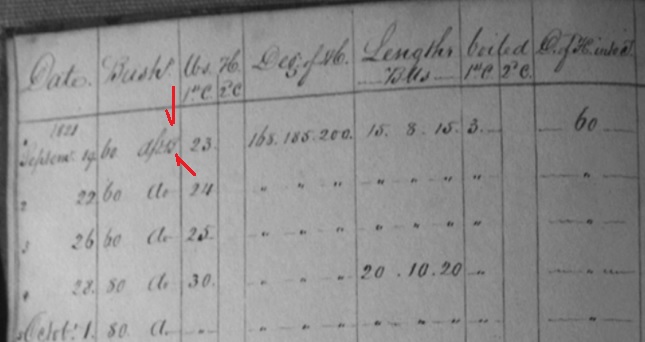 Brewing was seasonal in the early 1800s east coast towns. You see it in the Vassar logs from Poughkeepsie NY and again with the brewing logs of Francis and William Perot of Philadelphia of 1821-22. Ed Carson was good enough to scan them last fall and I am drawn back to them by
Brewing was seasonal in the early 1800s east coast towns. You see it in the Vassar logs from Poughkeepsie NY and again with the brewing logs of Francis and William Perot of Philadelphia of 1821-22. Ed Carson was good enough to scan them last fall and I am drawn back to them by
this question about what “cream beer” might be at that moment. That “B” up there is potentially very important. “Cream” is a word that gets used in a number of ways in brewing over the years so being fairly tight on what is being described is a good approach. In this exercise, I am trying to think about what it meant attached to “beer” in Philadelphia and also NYC in 1820 to 1925 or so. It is clear from the newspaper notices discussed last time it was (i) a novelty, (ii) desirable and (iii) local to Philadelphia. But what else can this year’s worth of notations tell us even though “cream” is never mentioned?
First, who is Perot? Highlighted above is the first log entry for the 1821 to 1822 season from the brewery of Francis and William Perot. Francis becomes quite accomplished. He was known for his cream beer.. His summary biography states:
Francis Perot (1796-1885) was apprenticed in 1812 to the 5th and 6th generations of Morrises (Thomas and Joseph). In 1818, Perot started his own brewery and malt house on Vine Street between 3rd and 4th Streets, bringing other family members into the business and marrying Elizabeth Morris. The Morrises turned their business over to Francis Perot. T. Morris Perot and Elliston Perot represent the 7th and 8th generations in the business — an unbroken line of descent in the business.*
More needs to be written and researched about Perot. For today’s purposes, we can stick to this one brewing year’s worth of log entries. I will post the log pages is a bit for purposes of your rebuttals and accusations but for now I see the following:
=> In 1821-22, all but one of the 87 brews of draft beer are noted as “home consumption.” But his ale is either mild (1/3) or “long keeping” (2/3). One batch of draft beer is shipped to Virginia;
=> As Ed pointed out, “the “Dft B” is less hoppy with 1 lb of hops to 3-5 bushels of malt, while the ale is .5 to 1+ lbs per bushel. And the Porter is the strongest with a hop rate of 1 to 1″;
=> In addition to the 87 batches of “Dft B” they brew twenty-one of Ale and eight of Porter. Like the Ale, their Porter has notes as to whether the batches are mild or for long keeping. They also each have, for certain batches, the notation “hops boiled twice”.
=> They brew doubles and singles off a single batch and in some cases three separate runnings. They appear to be kept at least initially separate as they are accounted for by number of barrels of each.
=>The log records that 57% of the bushels of barley went into the “Dft B” but it accounted for 75% of the batches produced. I have to count up the barrels for each batch as Perot does not total them but they do not appear to skew to the same ratio. It may well be that it is beer is lighter in strength than the Ale and Porter. Gotta do a bit more looking at that…
What to make of it? In the summary page, Perot uses the full term “Draught Beer” as opposed to “Porter” and “Ale” but what is odd is that low hopped brewing results in the “beer” which is the opposite of the normal usage of the word, isn’t it? By fifteen years later, we see regular ads for “cream ale” but at this point whatever is coming out of this Philadelphia brewery is called beer, looks like what gets called “cream” beer – and it has half the hops of their ale.
Later: The 1821-22 Perot Logs
Page 1 and 2 – 19 Sep 1821:
Page 9 and 10 – 23 Mar 1822:
Neato. There is plenty more to write about. As far as I can tell there may be five “creams” in US NE brewing history: pre-1825 Philly cream beer; 1835-1860s Taylor-style cream ale; 1860s-1910 cream ale; post prohibition cream light lager like Genny Cream; and craft cream… whatever that is. Much more work to do to see if that is right or if something else is going on.
*Cited this way in the family papers: “Information from: “A Condensed History of the Oldest Business House in America – The Francis Perot’s Sons Malting Co. of Philadelphia.” 1890.”

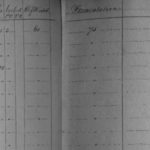

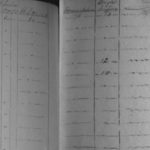

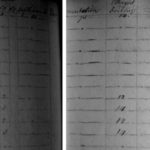







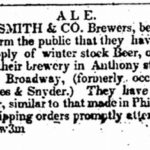

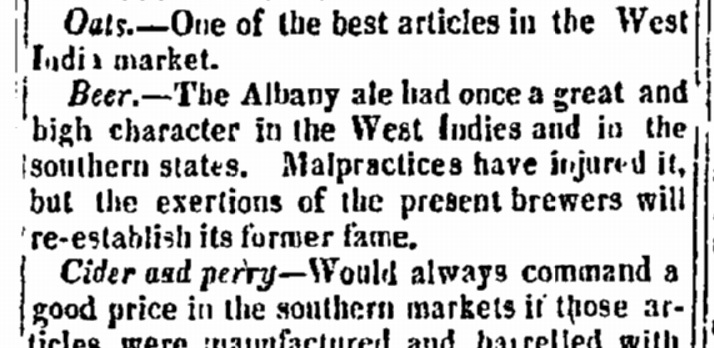
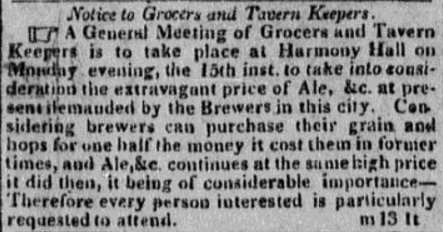

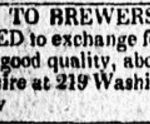
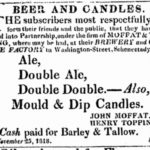
 Yet, the future was now. Science was coming to agriculture in upstate New York. Ben Franklin’s
Yet, the future was now. Science was coming to agriculture in upstate New York. Ben Franklin’s 